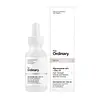What's inside
What's inside
 Key Ingredients
Key Ingredients

 Benefits
Benefits

 Concerns
Concerns

 Ingredients Side-by-side
Ingredients Side-by-side

Water
Skin ConditioningGlycerin
HumectantButylene Glycol
HumectantButylene Glycol Dicaprylate/Dicaprate
EmollientPentaerythrityl Tetraisostearate
EmollientVinyldimethicone
Cetyl Ethylhexanoate
EmollientNiacinamide
SmoothingC14-22 Alcohols
Emulsion StabilisingPhenyl Trimethicone
Skin ConditioningBehenyl Alcohol
EmollientHydrogenated Vegetable Oil
EmollientStearic Acid
CleansingArachidyl Alcohol
EmollientGlyceryl Caprylate
EmollientC12-20 Alkyl Glucoside
EmulsifyingCetearyl Alcohol
EmollientCaprylyl Glycol
EmollientArachidyl Glucoside
EmulsifyingCarbomer
Emulsion StabilisingArginine
MaskingPalmitic Acid
EmollientAllantoin
Skin ConditioningSilica
AbrasivePolyacrylate-13
Ammonium Acryloyldimethyltaurate/Vp Copolymer
Tocopherol
AntioxidantHydrogenated Lecithin
EmulsifyingEthylhexylglycerin
Skin ConditioningAdenosine
Skin ConditioningHydrogenated Polyisobutene
EmollientCeramide NP
Skin Conditioning1,2-Hexanediol
Skin ConditioningTocopheryl Acetate
AntioxidantCholesterol
EmollientSqualane
EmollientBisabolol
MaskingMacadamia Ternifolia Seed Oil
EmollientDimethicone
EmollientPolyglyceryl-10 Laurate
Skin ConditioningEthylhexyl Palmitate
EmollientOctyldodecanol
EmollientGlucose
HumectantBrassica Campestris Sterols
EmollientOleic Acid
EmollientSorbitan Isostearate
EmulsifyingT-Butyl Alcohol
PerfumingArachidic Acid
CleansingSodium Hyaluronate
HumectantRibes Nigrum Seed Oil
EmollientMyristic Acid
CleansingGlutathione
Caesalpinia Spinosa Fruit Extract
Skin ProtectingAsiaticoside
AntioxidantMadecassic Acid
Skin ConditioningAsiatic Acid
Skin ConditioningHelianthus Annuus Seed Oil Unsaponifiables
EmollientKappaphycus Alvarezii Extract
Skin ConditioningLactobacillus Ferment Lysate
Skin ConditioningLactobacillus Ferment
Skin ConditioningHelianthus Annuus Seed Oil
EmollientCardiospermum Halicacabum Flower/Leaf/Vine Extract
Skin ConditioningRosmarinus Officinalis Leaf Extract
AntimicrobialWater, Glycerin, Butylene Glycol, Butylene Glycol Dicaprylate/Dicaprate, Pentaerythrityl Tetraisostearate, Vinyldimethicone, Cetyl Ethylhexanoate, Niacinamide, C14-22 Alcohols, Phenyl Trimethicone, Behenyl Alcohol, Hydrogenated Vegetable Oil, Stearic Acid, Arachidyl Alcohol, Glyceryl Caprylate, C12-20 Alkyl Glucoside, Cetearyl Alcohol, Caprylyl Glycol, Arachidyl Glucoside, Carbomer, Arginine, Palmitic Acid, Allantoin, Silica, Polyacrylate-13, Ammonium Acryloyldimethyltaurate/Vp Copolymer, Tocopherol, Hydrogenated Lecithin, Ethylhexylglycerin, Adenosine, Hydrogenated Polyisobutene, Ceramide NP, 1,2-Hexanediol, Tocopheryl Acetate, Cholesterol, Squalane, Bisabolol, Macadamia Ternifolia Seed Oil, Dimethicone, Polyglyceryl-10 Laurate, Ethylhexyl Palmitate, Octyldodecanol, Glucose, Brassica Campestris Sterols, Oleic Acid, Sorbitan Isostearate, T-Butyl Alcohol, Arachidic Acid, Sodium Hyaluronate, Ribes Nigrum Seed Oil, Myristic Acid, Glutathione, Caesalpinia Spinosa Fruit Extract, Asiaticoside, Madecassic Acid, Asiatic Acid, Helianthus Annuus Seed Oil Unsaponifiables, Kappaphycus Alvarezii Extract, Lactobacillus Ferment Lysate, Lactobacillus Ferment, Helianthus Annuus Seed Oil, Cardiospermum Halicacabum Flower/Leaf/Vine Extract, Rosmarinus Officinalis Leaf Extract
 Reviews
Reviews

Ingredients Explained
These ingredients are found in both products.
Ingredients higher up in an ingredient list are typically present in a larger amount.
Niacinamide is a multitasking form of vitamin B3 that strengthens the skin barrier, reduces pores and dark spots, regulates oil, and improves signs of aging.
And the best part? It's gentle and well-tolerated by most skin types, including sensitive and reactive skin.
You might have heard of "niacin flush", or the reddening of skin that causes itchiness. Niacinamide has not been found to cause this.
In very rare cases, some individuals may not be able to tolerate niacinamide at all or experience an allergic reaction to it.
If you are experiencing flaking, irritation, and dryness with this ingredient, be sure to double check all your products as this ingredient can be found in all categories of skincare.
When incorporating niacinamide into your routine, look out for concentration amounts. Typically, 5% niacinamide provides benefits such as fading dark spots. However, if you have sensitive skin, it is better to begin with a smaller concentration.
When you apply niacinamide to your skin, your body converts it into nicotinamide adenine dinucleotide (NAD). NAD is an essential coenzyme that is already found in your cells as "fuel" and powers countless biological processes.
In your skin, NAD helps repair cell damage, produce new healthy cells, support collagen production, strengthen the skin barrier, and fight environmental stressors (like UV and pollution).
Our natural NAD levels start to decline with age, leading to slower skin repair, visible aging, and a weaker skin barrier. By providing your skin niacinamide, you're recharging your skin's NAD levels. This leads to stronger, healthier, and younger looking skin.
Another name for vitamin B3 is nicotinamide. This vitamin is water-soluble and our bodies don't store it. We obtain Vitamin B3 from either food or skincare. Meat, fish, wheat, yeast, and leafy greens contain vitamin B3.
The type of niacinamide used in skincare is synthetically created.
Learn more about NiacinamideWater. It's the most common cosmetic ingredient of all. You'll usually see it at the top of ingredient lists, meaning that it makes up the largest part of the product.
So why is it so popular? Water most often acts as a solvent - this means that it helps dissolve other ingredients into the formulation.
You'll also recognize water as that liquid we all need to stay alive. If you see this, drink a glass of water. Stay hydrated!
Learn more about Water